
Jayaprakash Narayan Srivastava, also known as JP and Lok Nayak, was an Indian independence activist, theorist, socialist and political leader. He is mainly remembered for leading the mid-1970s opposition against Prime Minister Indira Gandhi and calling for her overthrow in a "total revolution". In 1999, Narayan was posthumously awarded the Bharat Ratna, India's highest civilian award, in recognition of his social service. His other awards include the Magsaysay award for public service in 1965.

Lucknow is the capital and the largest city of the Indian state of Uttar Pradesh and it is the administrative headquarters of the eponymous district and division. Having a population of 2.8 million as per 2011 census, it is the eleventh most populous city and the twelfth-most populous urban agglomeration of India. Lucknow has always been a multicultural city that flourished as a North Indian cultural and artistic hub, and the seat of power of Nawabs in the 18th and 19th centuries. It continues to be an important centre of governance, administration, education, commerce, aerospace, finance, pharmaceuticals, information technology, design, culture, tourism, music, and poetry.

Ludhiana is the most populous and the largest city in the Indian state of Punjab. The city has an estimated population of 1,618,879 as of the 2011 census and distributed over 310 km2 (120 sq mi), making Ludhiana the most densely populated urban centre in the state. It is a major industrial center of Northern India, referred to as "India's Manchester" by the BBC. It is also known as the commercial capital of Punjab.

Aligarh is a city in the state of Uttar Pradesh in India. It is the administrative headquarters of Aligarh district, and lies 342 kilometres (213 mi) northwest of state capital Lucknow and approximately 130 kilometres (81 mi) southeast of the capital, New Delhi. The cities and districts which adjoin Aligarh are: Gautam Buddha Nagar, Bulandshahr, Sambhal, Badaun, Kasganj, Hathras, Etah and Mathura, as well as Palwal district of Haryana. As of 2011, Aligarh is the 53rd most populous city in India.

Keshav Baliram Hedgewar, also known by his moniker Doctorji, was an Indian political-social activist, physician and the founder of the Rashtriya Swayamsevak Sangh (RSS). Hedgewar founded the RSS in Nagpur in 1925, based on the ideology of Hindutva with the intention of creating a Hindutva.

Unnao is a city in the Indian state of Uttar Pradesh. It is the administrative headquarters of Unnao district and a part of Lucknow division, between Kanpur and Lucknow. Unnao is a large industrial city with three industrial suburbs around it. Unnao has the country's largest leather Export in the UPSIDC.
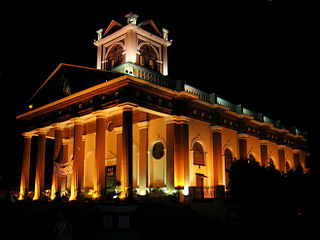
Kapurthala is a city in Punjab state of India. It is the administrative headquarters of Kapurthala District. It was the capital of the Kapurthala State, a princely state in British India. The aesthetic mix of the city with its prominent buildings based on French and Indo-Saracenic architecture self-narrate its princely past. It is also known as city of Palaces & Gardens. According to the 2011 census, Kapurthala is the least populated city in India.
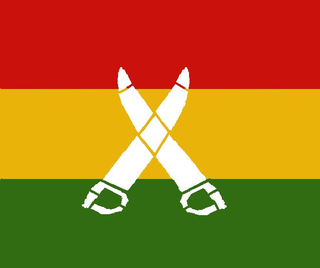
The Ghadar Movement or Ghadar Party was an early 20th-century, international political movement founded by expatriate Indians to overthrow British rule in India. Many of the Ghadar Party founders and leaders, including Sohan Singh Bhakna, would go on and join the Babbar Akali Movement and would help it in logistics as a party and publishing its own newspaper in the post-World War I era. The early movement was created by revolutionaries who lived and worked on the West Coast of the United States and Canada, but the movement later spread to India and Indian diasporic communities around the world. The official founding has been dated to a meeting on 15 July 1913 in Astoria, Oregon, and the group would splinter into two factions the first time in 1914, with the Sikh-majority faction known as the “Azad Punjab Ghadar” and the Hindu-majority faction known as the “Hindustan Ghadar.” The Azad Punjab Ghadar Party’s headquarters and anti-colonial newspaper publications headquarters would remain in the Stockton Gurdwara located in Stockton, California, whereas the Hindustan Ghadar Party’s headquarters and Hindustan Ghadar newspaper would relocate to be based in nearby Oakland, a suburb of San Francisco, California.

Bhikhaji Rustom Cama or simply as, Madam Cama, was one of the prominent figures in the Indian independence movement.

Lala Lajpat Rai was an Indian revolutionary, politician, and author, popularly known as Punjab Kesari. He was one of the three members of the Lal Bal Pal trio. He died of severe head trauma injuries sustained 18 days earlier during a baton charge by police in Lahore, when he led a peaceful protest march against the British Simon Commission Indian constitutional reforms.

Independence Day is celebrated annually on 15 August as a public holiday in India commemorating the nation's independence from the United Kingdom on 15 August 1947, the day when the provisions of the Indian Independence Act, which transferred legislative sovereignty to the Indian Constituent Assembly, came into effect. India retained King George VI as head of state until its transition to a republic, when the Constitution of India came into effect on 26 January 1950 and replaced the dominion prefix, Dominion of India, with the enactment of the sovereign law Constitution of India. India attained independence following the independence movement noted for largely non-violent resistance and civil disobedience led by Indian National Congress under the leadership of Mahatma Gandhi who adopted these values from one of the early movements in India led by Ram Singh Kuka.

Barabanki district is one of the five districts of Ayodhya division in the central Awadh region of Uttar Pradesh, India. Barabanki city is the administrative headquarters of Barabanki district. Total area of Barabanki district is 3891.5 Sq. km.

Aruna Asaf Ali was an Indian educator, political activist, and publisher. An active participant in the Indian independence movement, she is widely remembered for hoisting the Indian National flag at the Gowalia Tank maidan, Bombay during the Quit India Movement in 1942. Post-independence, she remained active in politics, becoming Delhi's first Mayor.
Kunwar Digvijay Singh, popularly known as "Babu", was an Indian field hockey player. He was born in Barabanki, Uttar Pradesh. He is widely known for his passing ability and is considered by many to be the greatest dribbler of the game comparable only to Dhyan Chand.
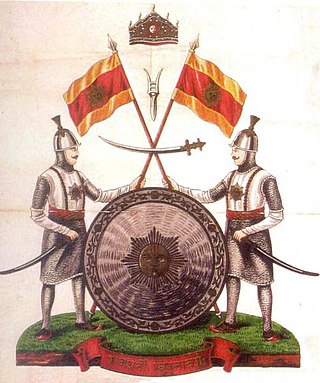
The Dogra dynasty of Dogra Rajputs from the Shivalik hills created Jammu and Kashmir when all dynastic kingdoms in India were being absorbed by the East India Company. Events led the Sikh Empire to recognise Jammu as a vassal state in 1820, and later the British added Kashmir to Jammu with the Treaty of Amritsar in 1846. The founder of the dynasty, Gulab Singh, was an influential noble in the court of the Sikh emperor Maharaja Ranjit Singh, while his brother Dhian Singh served as the prime minister of the Sikh Empire. Appointed by Ranjit Singh as the hereditary Raja of the Jammu principality, Gulab Singh established his supremacy over all the hill states surrounding the Kashmir Valley. After the First Anglo-Sikh War in 1846, under the terms of the Treaty of Lahore, 1846, the Government of India acquired Kashmir from the Sikh Empire and transferred it to Gulab Singh, recognising him as an independent Maharaja. Thus, Jammu and Kashmir was established as one of the largest princely states in India, receiving a 21-gun salute for its Maharaja in 1921. It was ruled by Gulab Singh and his descendants till 1947.
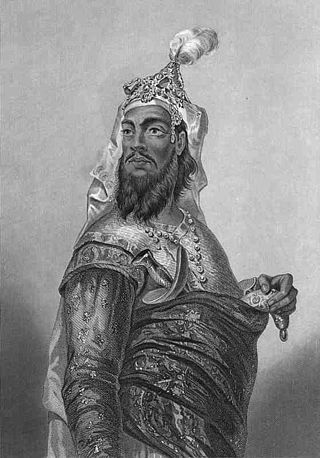
Kunwar Singh, also known as Babu Kunwar Singh was a chief organiser of the Indian Rebellion of 1857 from the Bhojpur region of Bihar. He was originally the ruler of Jagdishpur estate. He led a selected band of armed soldiers against the troops under the command of the British East India Company.
Amina Hamza Bazaar is one of the oldest market centers in the city of Lucknow, India, along with Chowk, Nathan's and Hazratganj. Its traders and shops are involved in both wholesale and retail commerce. The main commodities and goods traded are clothes, Chikan embroidery work, spices, dry snacks, hosieries and wedding decorations. In fact, Aminabad is a combination of various markets, cluster of houses, offices and is often compared to the bustling Chandni Chowk of Delhi.
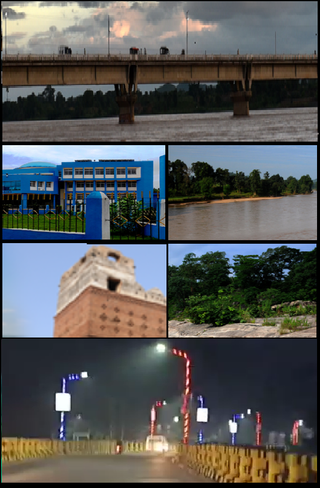
Medininagar, formerly Daltonganj, is a city municipal corporation in the Indian state of Jharkhand. It is the headquarters of Palamu division and Palamu district, as well as the subdivision and block of the same name. The city is situated on the banks of the North Koel River.

Sri Ramakrishna Math, Lucknow is a monastic organisation for men created by Ramakrishna (1836–1886), a 19th-century saint of Bengal. The motto of the Ramakrishna Math and Ramakrishna Mission is: "For one's own salvation, and for the welfare of the world". It contains idols of Ramakrishna, Swami Vivekananda and Holy Mother Sarada Devi.

Tanha Ansari was a Kashmiri poet and school teacher. He wrote in Urdu, Kashmiri, Arabic and Persian languages. He is primarily known for his rebellion poetry against Dogra rule in Jammu and Kashmir princely state, however his work went unnoticed until 1947. After the partition of the Indian subcontinent, he actively participated in Kashmir freedom movement through his writings.


















